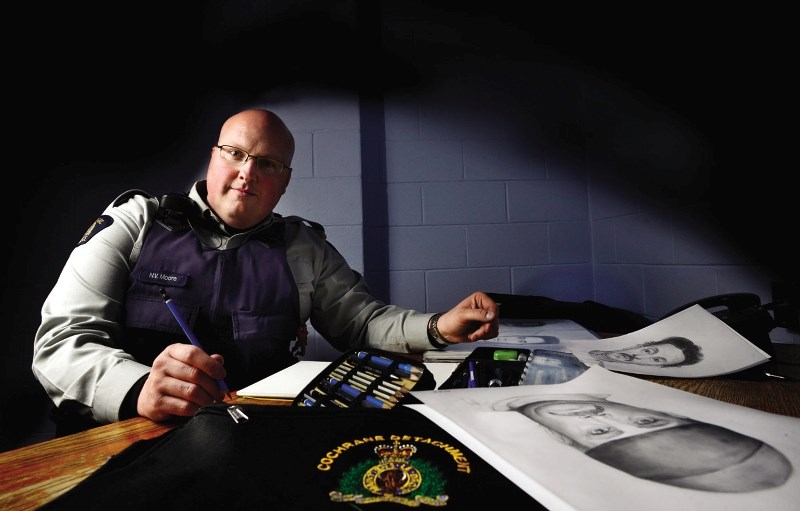Constable Nathan Moore has come a long way from high school art class masterpieces and superhero doodles.
Now, his artwork is less about heroes, and more about villains.
A municipal traffic member for the local RCMP detachment, Moore stands apart as one of four RCMP composite sketch artists in the province. He’s sketched depictions of bad guys and gals from as far away as Yellowknife, N.W.T., to communities — like Cochrane — scattered throughout Southern Alberta.
“There’s more to composite drawing than people think,” explained Moore, who began sketching in 2009. “It’s not about a witness describing a suspect to you, instead (the witness) is asked to recognize facial features.”
With that, he opened the FBI Facial Identification Catalogue and began flipping through the pages. The catalogue is packed with photographs of faces, with sections on eyes, noses, ears, chins, hair and more.
Catalogue in hand, Moore said he sits down with the witness or crime victim, and has them look through the pages. He asks basic questions: Would they recognize the suspect if they saw him/her again? Did the suspect have any distinguishing features?
“The composites aren’t supposed to be a perfect portrait,” he remarked, as he thumbed through a portfolio of his sketches. “It’s really more about standout features — almost like a caricature.”
Moore scored his position in Cochrane in August 2012, after a stint with the Raymond/Magrath detachment. This year marks his seventh as a police officer.
He estimates he’s rendered likenesses of more than 50 faces over the course of his five years as a composite artist. He said it takes about five or six hours to get through the entire process — from interviewing the witness until the image is ready for release.
Demand for composite artists in the area is hit and miss. Moore’s busiest week saw the creation of four sketches – but that followed a month-long dry spell.
He has drawn the faces of armed robbers, murderers, home invaders; he’s even created an image to help police identify a dead body.
The biggest challenge, he said, is time. But the end result is worth it.
“The most rewarding part of sketching is coming up with an image the client is satisfied with — how close it is to what they remember and comparing it to the suspect when charged,” said the self-described perfectionist. “The end result is seeing how close a description is to a suspect.”
Most recently, Moore sketched a culprit believed to be one of a trio of men responsible for a break and enter at an Airdrie home April 18.
Composite drawings, when done well, aid investigations in a number of ways, said Rick Parks, of Stuart Parks Forensic Associates. Parks, along with his wife Carrie Stuart Parks, teach composite and forensic art classes throughout the U.S. and Canada.
Not only does the sketch help investigators find and eliminate suspects, but it also assures the public that police are working to solve the crime, said Parks. Additionally, he said it brings the public into the fold — police want citizens to see and react to composites.
“Even if a sketch generates just one tip, that’s one tip we didn’t have before in the investigation,” said Cochrane Staff Sgt. Roger Waidson.
“All the image needs to do is this: help other people recognize the face,” said Parks, who logged more than a decade as a visual information specialist for the FBI. “The sketch doesn’t need to be perfect.”
Although he’s been drawing since a young age, Moore’s formal sketching instruction began when he applied through the RCMP. Since then, he’s participated in four workshops, including a number offered by Stuart Parks.
“(Moore) is a perfect example of who our services are geared towards,” said Parks, who teaches both police and civilians. “He was enthusiastic to be there, he worked hard and it’s paid off.”
And Moore’s not done yet. He said the future of composite sketching remains bright, despite speculation of technology taking over the traditional pen-to-paper method.
“There’s always a need for artists,” he said. “There’s some debate as to whether or not physically drawing an image is the way to go, or if computer programs may be used. Fortunately for me, this is the way we do it. And I look forward to doing it for years to come.”




